How to Find the Right CSA
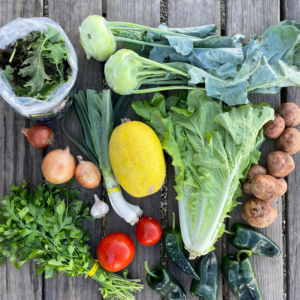
You want to get a box of veggies each week from your local farmer… but how do you find the best CSA for you?
So you’ve decided you want to join a CSA, and now you’re ready to find one.
There’s just one problem.
Where do you begin?
Starting a search for the “right” CSA can be overwhelming.
This article is going to try to help you figure out the questions you should even be asking yourself. How are CSAs fundamentally different from each other? What features should you be looking for? How do you even find them?
In this article I guide you through the 12 starting point questions to ask yourself as you compare the different CSAs around you. This will serve as a roadmap to navigate these unchartered waters and help you make a solid decision.
My goal isn’t necessarily for you to choose our CSA program. I actually really just want you to end up in the “right” CSA for YOU. Because it does me no good to have a customer that isn’t clicking with our unique CSA signature. I want happy customers. (To learn how our specific CSA program works, click here.)
So if this information leads you to decide to choose another farm, that’s good for both of us.
Use these questions to help you identify the things to look for as you select the farm that’s right for you.
So are you ready to dive in?… Here we go.
STEP 1: WHERE DO YOU FIND THE CSAs?
The first step is to locate the farms in your area that offer CSA. How do you find them?
Luckily, there’s an easy answer to this question. And it’s www.LocalHarvest.org. This is a website where farmers can list their farm and their CSA. And because it’s free, most farmers use it.
If you want to find out what CSAs are in your zip code, this is the place to go. Simply click in the search bar near the top and type “CSA” then enter your city or your zip code in the search field adjacent to that.
Your search results will show all the CSAs within a certain mile radius. The farms are listed in alphabetical order. Now a quick disclaimer: I find that the listings aren’t always kept up to date. But at least it gives you a starting point to work with.
Another app you can use is called GrownBy.app — This is a newer app you can install on your phone, and it will help you locate any local farm in your area (and place orders!). If you see your favorite farm that hasn’t created a listing yet, you can “invite them” to create one.
You can also try Google. Type in a phrase like “organic farms near me” or “CSA farms near (your city/state)” — interestingly, I find that many of my customers find us using Google! If you go this route, look for the farm’s overall Google Reviews rating. This will help you weed out the finalists.
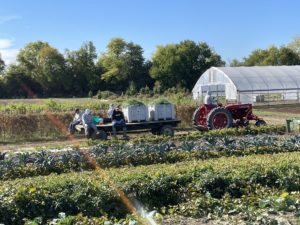
STEP 2: Look at their pick up site and delivery options.
The next step to helping you narrow down your CSA is checking out the pick up site window or delivery options.
CSAs will offer multiple places to pick up their produce (or beef or whatever you’re looking for). Most of them offer their home farm, but almost all will offer at least one other option for pickup.
These pick up windows are usually set times every week, and these pick up times are set in stone. So if you can’t make it to that time slot, you can take that particular CSA out of the running. It’s why I place this step near the top of the process – it helps you narrow down your choices considerably.
Some farms will offer a LOT of pick up sites. Some will offer only a few. It doesn’t really matter who has the most. What really matters is: “Does the farm I want offer a pick up site that works for ME?”
If you opt for a “choice” CSA (more details on that later), you may have the option to show up to a farmer’s market and choose your own contents right there at the stand up to a certain dollar amount. In that case, you’ll have a larger window of time while the farmer is at the market.
If convenience is important to you, you’ll want to look for a CSA that offer home delivery. However, keep in mind that farms will charge a pretty penny for this service — often $10-$15 per delivery. You’ll still be responsible for setting out a big cooler on your porch with ice, so that when the box shows up in the hot afternoon, the driver can put your produce somewhere cool until you get home. You’ll likely notice that your connection to the farmer (and the farm) isn’t as strong if you choose this option, because you aren’t seeing them each week at pickup.
For this step, you’ll need to ask yourself, “How important is the pick up location for you? Does it trump all the other features? Or are you somewhat flexible?” What if the pick up location is close by, but another farm (which is further away) offers a fruit share or is certified organic? Do I need a farm that offers home delivery?
STEP 3: What types of shares do they offer? Is variety of selection important to you?

Shares will often come in different sizes. Choose the one that fits your family.
CSAs will offer different packages or “share” types, and in this step you need to compare the varieties and decide which ones you want. In addition to veggie shares, you might see egg shares, chicken shares, coffee shares, bread shares, cheese shares, milk shares, beef shares, flower shares, honey… There’s just about a share for everything these days.
You’ll also want to look at the VOLUME of the weekly share. How much food are you getting? Some farms will offer “large,” “small,” or mini. Think through how much you will use on a weekly basis, as well as how much you could freeze for later use.
One of the features customers often like about CSAs is that they offer a “one-stop” shop for a wide variety of local products. Some people really value the convenience factor of having one CSA that gives them everything in one place. The more choices the better.
Look for an option to “try out” the membership. Some CSAs will offer a 4-week trial subscription to give you a lower-risk experience. This is a great way to audition the CSA to see if it fits with your lifestyle before you make a big investment. We offer this option with our CSA Sampler membership. (See what it looks like here).
This is one way you can compare CSAs. Some of them will only offer 1-2 types of shares. Some will offer the whole kit and caboodle. And others will be somewhere in between.
You need to decide if this is the most important factor or not.
STEP 4: Count the Cost.
After you’ve made up your wish list of share types you are trying to find, you need to compare the investment. Keep in mind that CSAs will often be a more expensive than grocery store costs (if you itemize each item you receive).
As you look at the numbers, be sure to factor in a few things…
Pay attention to the SIZE (or volume) of the share type. This can be difficult to standardize because different farms call their shares by different names. For example, you might see words like: “Standard share,” “Full share,” “Half share,” “Family Share,” “Senior Share,” and more. How are they different? And which one do I start with?
I always tell families who are starting out with our CSA to choose the smallest share size – something basic like a half share or standard share. The bigger (and more expensive) shares are for families that have over 4 kids and that eat or preserve a lot of veggies each week.
If you’re just starting out and getting your feet wet, don’t overdo it. Work your way into the CSA way of life slowly and get your bearings.
Another way to compare price is to pay attention to the number of WEEKS in the farm’s CSA season. Some will go 18 weeks, 20 weeks, 25 weeks. Some will offer multiple seasons, breaking it up into spring, summer, fall or winter sections. Some will set you up for a weekly subscription until you cancel. (This is nice if you don’t want to have to worry about renewing your membership).
Eventually you’ll have to do the math. Try to find two share types that are similar in quantity. Then divide the cost of the similar shares by the number of weeks to figure out your cost per week. This will help you compare apples to apples.
You’ll likely notice that some farms may end up at a higher price per week than others. And if you see that, before you walk away, you may want to ask yourself, “WHY is that?”
Take a look at the other features they offer in their membership package… it may be that these features carry added value.
For instance, in our case… our CSA’s cost is higher than the average, but we also offer an amazing support system for our membership with our highly engaged private Facebook community, AND our digital CSA Academy resource library that teaches our customers the roadmap to CSA success in a short amount of time. That’s got a lot of extra value, and is something that other farms don’t offer to the degree we do. So our cost is higher.
If you know that you won’t be using those features of membership, then taking the less expensive CSAs might be a natural step. Pay for the features you know you’ll use.
STEP 5: Ask about their “Growing Practices.”

If you care about what’s going into your food, make sure you look for the USDA certified organic label.
Let’s be honest. Most people looking for a CSA like the idea of supporting a local farmer, getting behind sustainable agriculture, protecting the environment, and “clean” eating.
You don’t find too many CSA prospects that don’t care about how their food is grown.
So if you’re reading this article, you are likely at some point going to ask yourself “How important are the farmer’s growing practices to my decision?”
There are all kinds of labels out there, “organic”, “made with organic”, “certified organic”, “100% organic,” “grown using organic practices,” “in transition,” “grass-fed, grass-finished,” “conventional.”
Learn what these words mean (because they are NOT all equal). The gold standard is “certified organic” or “100% organic.” Figure out which labels are deal-breakers for you. (They may not be!)
Don’t be surprised if farms carrying the gold standard are priced higher.
For a long time, we just farmed “using organic practices.” But we didn’t have the official certified seal. Our customers told us they trusted us and didn’t need to see that USDA logo on our sign. But over time, having that seal became important to us as farmers. We wanted to draw a line in the sand and say, “This is so important for us that we’re willing to go thru all the hoops to make it official.”
We are now a USDA certified organic farm. We feel like this decision has removed a barrier that some of our prospects may have had to joining our farm. And that has premium value for us.
I can’t tell you which growing method is better or best. This is ultimately YOUR judgment call. How important is the way in which the farmer grows your food?
And does it trump everything else?

CSAs will often offer you unusual varieties of produce that are “hard to get.” As a CSA member, you should get first choice on these unusual products, because you are considered the “premier” customer.
STEP 6: How much choice do you get as a customer?
CSAs differ on how they disburse their farm’s product to you.
Traditional CSA (Farmer’s Choice): Some will decide FOR you what you’re going to get in your share that week. They pre-pack it the day of or the night before. You pick it up and go. Known as the “traditional” type of CSA, this is the kind we offer. This style will push you to try new veggies and grow your veggie edge.
Free Choice CSA: Some will give you ALL the choice. They harvest what they have, set it all out at the pick up site, and indicate how much of each item you’re allowed to take if you want it. You get to literally pack your share in real time at the pickup. Other CSA’s might have fancy software that allows customers to set their veggie preferences (so you never get beets) and pre-order online the week before. They send you an email telling you what’s available for harvest, and you can go into the software and customize the box. If you forget to do so, you just get the “default box” for the week (like a traditional CSA). You could say, “I don’t want the cilantro. Instead, I’ll take an extra portion of lettuce.” You can even add on extra items above and beyond (and pay for them with a credit card).
Market-Style CSA: Some farmers will allow you to buy “store credit” or a gift card. Then you show up each week at your pickup site and “buy down” from your card. Or you simply go into their online store for CSA members and “customize” your order to fit the weekly allotment. They may put some restrictions on how much you can take of certain items.
And still other CSAs will offer “extras” – above and beyond the core pre-packed box. You can choose additional fun or unusual items to add into your share from the crates of bonus items at no extra cost.
Each of these options obviously has its pro’s and con’s.
If you like the idea of having someone else decide what you eat that week – and you enjoy a spirit of adventure — you won’t mind a pre-packed box.
Or if you want someone to “force you” to try new things (cuz you’d never choose garlic scapes on your own), then you might really love having the pre-packed box.
On the other hand, if you value choosing your own ingredients because you want more control over your meal plans, then you’ll be looking for a CSA that offers a customizable box approach or a YOU PICK option.
Our farm offers a pre-packed box of core staples (which includes one unusual item to push your comfort zone and challenge you) plus a table full of bonus freebies that allows you to customize a part of your share.
STEP 7: Culinary Training and Support – Do they help you use the produce?

Find out if your CSA has a membership site or private Facebook group, where you can get support from other members of the CSA for eating your food.
CSAs are primarily responsible for growing your food for you… getting you a quality product from their fields that will taste better than something you’d get at the grocery store.
But most CSAs these days are also trying to give you some ideas for how to use their product. At the very least, it’s pretty standard for CSAs to offer weekly recipes and storage tips.
But it’s also true that many CSA rookies hit a wall their first year when they start getting things they don’t know what to do with, or they get overloaded by greens or tomatoes or corn. Or they don’t know how to preserve their items to keep them lasting as long as possible.
(This is completely normal by the way. I always tell my new customers to expect this, and not give up. It takes about 3 seasons of “pushing through the wall” to change how you eat. For some, they aren’t willing to invest for that long.)
The good news is that this time is shortened when you have a CSA that does a good job of coaching you and equipping you during your season in HOW to eat the box.
If this support matters to you, find out if your CSA offers training to help you use the box. And if so, to what degree? How do they support you in using the produce when you get it home?
We’re learning that this is a key piece to long-term customer satisfaction. As a result, our farm decided to put some serious investment in developing our customer onboarding process.
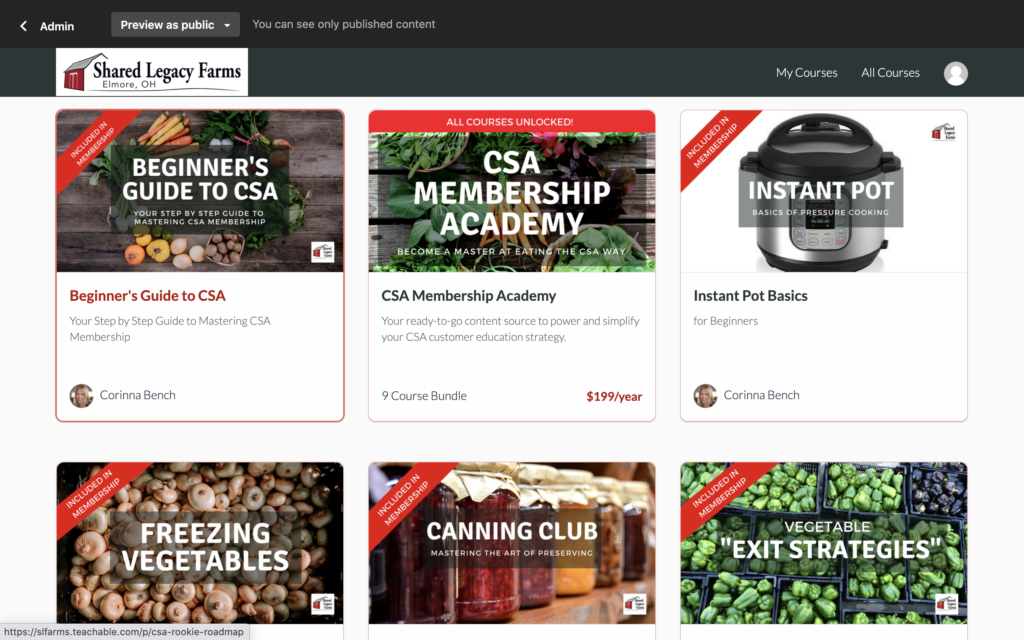
Our CSA Academy is like a Netflix for CSA members! Anyone can join to help support their CSA experience — no matter where you live. Use coupon code TRIAL to get your first month for $1. After that it goes to $19/month. Cancel anytime.
We have an online “CSA Academy” library that all our CSA members get for free. It includes resources like our “Roadmap to CSA Success” mini-course, our modules on “Vegetable Exit Strategies” (short videos of cooking techniques used by our CSA masters); our “Veggie University” (veggie guides and trainings for every vegetable); our “Canning Club” (videos and downloads for how to can over 10 different recipes); and our weekly box Recipes guides.
P.S…. If you’re thinking, “Oh my gosh, I wish I could get into that Academy to help me with my CSA experience!” — you can subscribe to our Academy for a monthly fee. (To try it out, enroll here and use the coupon code TRIAL to get your first month for only $1. After that, it bumps up to $19/month until you cancel. You can cancel at any time).
We’ve also got a private Facebook page (the site of our video training), where our members can connect and learn from each other. It’s kind of like a giant support group of foodies all talking to each other. (Learn more about our CSA here).
That’s a huge bonus feature of our CSA that’s reaping big dividends for customers.
Again, not all CSAs do this to such a degree. And maybe you don’t need this support. So it’s just a matter of what’s most valuable for you.
So find out what kind of education/ training and support the CSAs offer you to use the food they grow.
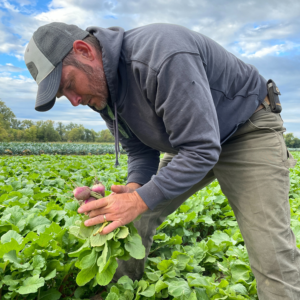
STEP 8: Take a look at their online presence.
Check out the CSAs’ websites to see if they offer any special added benefits online – do they have a blog you can learn from? Other PDFs you can download like a harvest calendar or How to Storage Guide? Do they have a Recipe database or cooking tips? Do they offer lots of ideas and tips on their social media channels?
Now a word on websites… I will say don’t be surprised if you don’t see great quality in farmer websites yet. Farmers are busy growing food for you. And website maintenance may not be in their wheelhouse. So go easy on them if the website isn’t superstar.
Do they have a Facebook or Instagram presence? This is almost more important than their website these days. I would highly recommend you visit the Facebook page for each CSA. A lot of times the images you see give you a good idea of the energy on the farm, the culture of the farm, and the overall vibe of the business.
In addition to the basic business Facebook or Instagram page, ask if they have a private Facebook group for CSA members only.
Private Facebook groups are incredibly valuable, and here’s why. If facilitated well, they become a place where all your members can connect with each other, create community, share ideas, ask for tips, and receive encouragement. (Membership in our Facebook group is free when you become a CSA member. It’s also included when you join our CSA Academy).
Facebook groups are also a great place to do some teaching. Some farms (like ours) do weekly live broadcasts to share cooking demonstrations or unpack the boxes and help you identify the veggies. You get storage reminder tips and basic uses of each veggie. (Learn how to sign up for our CSA here).
For some people, having this strong online presence and branding is important. Since so many of us are on social media every day, we rely on this platform to help us feel connected to the farm.
Remember: this group of people will become “your tribe.” How well that tribe is groomed and supported may just matter more than you think, and may create a better overall user experience.
STEP 9: Identify “Extra features.”
So every CSA will have its strength. And this is kind of hard to find out because they don’t all necessarily spell out those features in their product description.
Here are just a few examples of extra features you might find as you compare CSAs.
- Do they have excellent customer service? Are they NICE to you?
- Do they communicate well with you and let you know what’s coming each week?
- Do they have farm events for the kiddoes? Do you care if they do?
- Do they offer the option to hold your share or switch your site when you’re out of town?
- What happens when you miss your box? Do they save it for you?
- Do the offer farm dinners?
- Can you buy additional items from the online store to supplement the weekly default box?
- Do they offer affiliate partnerships with other valued vendors in your area?
- Do they require a work commitment of some sort? Volunteer hours each week?
STEP 10: Find out the payment options and refund policy.
Most CSAs will require you to pay some kind of deposit when you sign up as an act of “good faith.” This helps the farmer avoid having to take out loans to cover their expenses before the season starts.
But the payment plans differ from farm to farm. And for some of you, this may be a deal breaker. Our farm requires 50% down at sign up, and 50% down by June 1 (with room for exceptions if needed). This is pretty standard.
But some CSAs will have a smaller amount required for deposit –say $50 and the rest due the week before the season starts.
More and more CSA farms offer a weekly subscription, where you pay as you go. If you need to take a week off, you simply go in and put the CSA “on hold” for that week. The subscription continues until you cancel it.
Payment methods also vary. Credit card and checks are the most common methods.
Find out what their refund policy is.
Most CSA farmers will refund you if you back out before the season begins. (There may be a non-refundable deposit portion though, so check).
Some CSA farmers will also refund you if have to re-locate mid-season (pro-rated). But not all CSAs will refund you if the reason you are leaving is dissatisfaction with your CSA experience mid-season. The general rule of thumb with CSAs is that once it starts, “you make a commitment for the year no matter what.”
Now before you judge your farmers for this policy, try to put yourself in their shoes. It’s very challenging for a farmer to have a whole bunch of people back out mid-season, leaving them with open spots (and income gaps) they were counting on and now can’t fill.
On our farm, we offer a pro-rated refund for any reason once the season begins, although we do ask that you give the CSA a good-old college try for at least 4 weeks.
We didn’t always offer this generous refund policy in our early years. But after 9 years, we’ve gotten to the point in our business where we usually have a wait list, making it easier for us to easily replace those who need to exit.
(Learn more about how to join our CSA here.)
STEP 11: Read reviews of the farms on Google or Facebook.
If you’re like me, before you buy anything on Amazon, you read the reviews. Or at the very least, you see how many stars the product gets.
Reputation matters.
So do your research. Go and see what people are saying about your CSA farms. Look for reviews on Facebook or Google. Scroll through the comments.
See if your CSA has a testimonials page on their website.
Look for answers to questions like these:
- Is the quality of the product good?
- What are the pain points?
- How many reviews are there?
- What else are people saying about the farm?
- How is it adding value to customers?
A lot of times you can learn a lot about the “average” customer experience simply by reading reviews.
Step 12: Find out some important stats.

Ask your farms what their retention rate is. SUPER important statistic. And I promise you, farmers know the answer (although they may not all advertise it).
Specifically: How big are they? How long have they been doing CSA? And what is their customer retention rate?
Asking the size of the CSA is important for a couple of reasons…
First of all, if the CSA has several hundred or even a thousand members, you can probably safely assume it’s a strong CSA. Popular CSAs often attract the most customers.
That being said, there are lots of farms that purposely keep their CSA operation smaller (under 50), so they can give their customers a customized and personal experience. Which is why you should also ask how many years they’ve been doing a CSA.
Experience matters. If the CSA is small in size, but it’s been around for a while, it shows that they’ve chosen to stay small for a reason.
If this is their first or second year, that might explain their small size, as it takes a while to build up a following. You’ll get a LOT of interaction with your farmer, which is a great thing. But you MAY also go through some aches and pains as your farmer learns the ropes.
We sure are grateful to our “founding” twelve customers who stuck with us the first 2 years. We made mistakes, and they had committed hearts. So it was a good fit.
Keep in mind that really large CSAs will likely feel more impersonal for you — you may have to work harder to connect with the farm.
To be fair, that’s because it’s impossible for the farmer to get to know 1000 people well. And he/she will likely have a strong team of staff members who will be their ambassadors.
So you will sacrifice some of the “personal connection” in these larger CSAs. However, a large CSA also likely has quite a volume of product to pull from, so you will have a strong variety of veggies in your box each week.
The CSAs retention rate is also a VERY important statistic that will tell you about the health of the CSA. The industry’s national average is around 50%.
Think about that for a minute: half of the people who join their first year don’t renew the next year. That means you have a 50/50 chance on “most” CSA farms.
Unless… your CSA has a high retention rate. That’s a sign they’re doing something different to keep their clients happy.
If a farm has a higher retention rate, it’s an indication that you’ll probably have a great experience, that your farmers take good care of their customers, have a quality product, and help their customers progress in their goals for eating more local food.
Anything above 70% is a really strong number. Our farm has enjoyed a rate between 85-95% since 2020.
If you find a high retention rate, jump on board. It’s a very good sign.
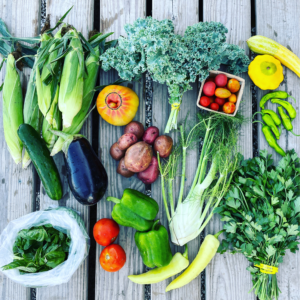
Well that was a marathon.
Before I sign off, I want you to remember that not all of the questions will hold equal weight with everyone. These are just the main questions to consider. YOU have to decide which features trump the others.
Is pick up location more important than cost? Is online presence and support worth the extra money? Will you take advantage of the added features? Do you need a fuzzy relationship with a farmer? Or are you just wanting the best vegetables of them all?
The questions in this article will serve as a roadmap to guide you in your decision.
Remember the big picture… not all CSAs are created equal. We each have our signature move.
And this is a big financial and emotional investment for you. So do your research. Know what you’re getting yourself into.
The key to having a good CSA experience is making sure you manage your expectations.
If you decide you want to check out our CSA in the metro-Toledo area, we would LOVE that. And we’ll take good care of guiding you through your experience.
But first I want you to look around and make sure you’ve checked out the other ones in our area. Because ours may not be the best fit for you.
Or you may not be a good CSA-fit in general… shich is also okay.
Armed with these 12 questions, you are now in good shape to finding your ideal CSA that fits your unique style.
You got this! Good luck.
-Farmer Corinna
